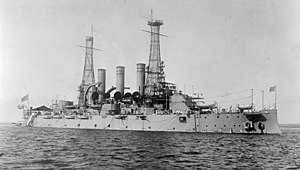 USS Rhode Island (BB-17) underway
| |
| History | |
|---|---|
| Name | Rhode Island |
| Namesake | Rhode Island |
| Builder | Fore River Shipyard |
| Laid down | 1 May 1902 |
| Launched | 17 May 1904 |
| Commissioned | 19 February 1906 |
| Decommissioned | 30 June 1920 |
| Fate | Sold for scrap, 1 November 1923 |
| General characteristics | |
| Class and type | Virginia-class battleship |
| Displacement | |
| Length | 441 ft 3 in (134 m) |
| Beam | 76 ft 3 in (23 m) |
| Draft | 23 ft 9 in (7 m) |
| Installed power |
|
| Propulsion |
|
| Speed | 19 kn (35 km/h; 22 mph) |
| Complement | 812 |
| Armament |
|
| Armor |
|
USS Rhode Island (BB-17) was the last of five Virginia-class battleships built for the United States Navy, and was the second ship to carry her name. She was laid down in May 1902, launched in May 1904, and commissioned into the Atlantic Fleet in February 1906. The ship was armed with an offensive battery of four 12-inch (305 mm) guns and eight 8-inch (203 mm) guns, and she was capable of a top speed of 19 knots (35 km/h; 22 mph).
The ship's career primarily consisted of training with the other battleships of the Atlantic Fleet. Rhode Island took part in the cruise of the Great White Fleet in 1907–1909, and thereafter largely remained in the Atlantic. In late 1913, she cruised the Caribbean coast of Mexico to protect American interests during the Mexican Revolution. After the United States entered World War I in April 1917, Rhode Island was assigned to anti-submarine patrols off the east coast of the US. Starting in December 1918, after the end of the war, the ship was used to repatriate American soldiers. She carried over 5,000 men in the course of five trips. She was briefly transferred to the Pacific Fleet in 1919 before being decommissioned in 1920 and sold for scrap in 1923 under the terms of the Washington Naval Treaty.